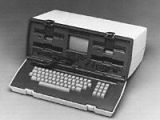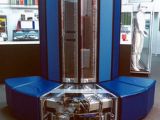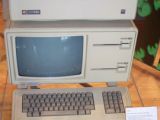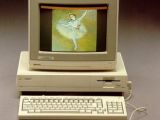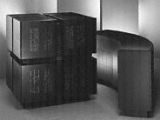Ready for some more historical facts about computers? OK, now, as you may still remember, the first part of this series of articles presented the evolution of computers up to the year 1981, when IBM (International Business Machines) introduced the "PC" brand-name and initialized the chain explosion of the personal computer market. IBM became a very powerful and respected company, which saw immense revenues from PC sales in the last decade of the 20th century. IBM started experiencing problems as soon as Y2K, but even now, in 2006, it is considered one of the most important companies of the IT&C world. Curious to know what the IBM PC proudly boasted at its August 12, 1981 launch? It included an Intel 8088 microprocessor, which was clocked at 4.77 Mhz, 16 KB and 640 KB of memory and the whole thing arrogantly made use of Microsoft PC-DOS 1.0, MS-DOS or IBM's own BASIC programming language. In addition, the first model could support up to two 5 ?" floppy disk drives. We're still in 1981, when Adam Osborne took miniaturization to new heights. He completed then the first portable computer named Osborne I, which weighed an impressive 24 pounds.
Not that portable compared to present-day standards, right? But it also cost only $1,795, a price that made it a best seller considering the fact that the included bundle of software worthed by itself at least $1,500. It sported many features that hadn't been implemented into PCs yet: 64 KB of memory, a modem and two 5 ?" floppy drives along with a 5" display. Immediately after Osborne I's release, the IT&C community went nuts about this new development. "I recently had an opportunity to see the Osborne I in action. I was impressed with it?s compactness: it will fit under an airplane seat. (Adam Osborne is currently seeking approval from the FAA to operate the unit on board a plane.) One quibble: the screen may be too small for some people?s taste." commented Chris Morgan, Editor in Chief at Byte Magazine in his April 1981 article "Future Trends in Personal Computing".
The IT&C world was stormed by several important achievements in 1981, as you can see. I cannot move on without mentioning the emergence of the first work station ever recorded.
Apollo Computer was clever enough to offer the DN100 model, which performed better than several microcomputers at a fraction of the price. In 1982, Sun Microsystems followed Apollo Computer's strategy and this is how the work station market was born. These two companies (Sun Microsystems is still holding on) began to optimize their machines for computer-assisted graphics and engineering software.
1982 brought the Cray XMP supercomputer, a model that really deserves to be called a SUPER computer. Although its predecessor - Cray I - was outstanding for 1977, reaching 166 million floating-point operations per second (MegaFLOPS) and featuring a clock rate of 83 million cycles per second (83 Mhz) complemented by 64bit technology and a 128 instructions set, this may not impress any hardcore overclocker or enthusiast of 2006.
Cray XMP continued the vector-processing legacy and practically doubled and surpassed the previous speeds, reaching 420 MegaFLOPS. The Cray XMP model was the first supercomputer to incorporate a parallel processing interface, allowing two models to work together on the same problem, further doubling the processing speed. The XMP model was intensively used by research institutes and defense corporations due to its relatively low cost of implementation (I'm talking about a couple of millions of US dollars here, still a smaller amount compared to Cray 1's $9 million price).
Retuning to the personal computing side, 1982 was the year that inaugurated the Commodore 64 PC (C64 for short). This model featured only 64 KB of RAM but compensated this with an impressive graphics and a price of $595. The versatility of the graphics potential was appealing to many software companies, as thousands of programs and games were written for the C64. The model ultimately became a legend in the PC business, when in 1993 - the year of its discontinuation - it had already sold more than 22 million units. Managing to get into The 2006 Guinness Book of Records, the C64 is acknowledged to be the best selling single computer model up to this date.
Moving to 1983, we see Apple setting the PC trend with its Lisa model. The Lisa became an example for the future generations because it is considered to be the first PC to integrate a working graphical user interface (GUI). The Lisa was powered by a 5 Mhz Motorola 68000 microprocessor and came equipped with 1 MB of RAM, a 12-inch black-and-white monitor, dual 5 1/4-inch floppy disk drives and a 5 megabyte Profile hard drive. An unfriendly price of $10,000 as well as unappealing size largely contributed to its failure. It is said that Lisa had a bunch of features copied directly from Xerox's Star PC model. The Star ran on a special OS called Smalltalk, involving windows and pop-up messages, which took full advantage of the integrated mouse.
Compaq Computer Corp. managed to introduce its first PC clone in 1983, selling models for a cumulated total of $111 million by the end of the year. Seeing IBM's success with its PC models, Compaq initiated an IBM-compatible computer market that transformed the company into a great rival for the Big Blue. The first IBM PC clone from Compaq was actually designed with reverse-engineering techniques in order to make it 100% compatible with IBM genuine hardware. Compaq resolved in controlling as mush as 83% of the personal computer market by 1996.
The personal computer world remembers 1984 as the year when Apple launched its highly acclaimed Macintosh model. The Macintosh resolved to become the first successful mouse-driven computer with a decent GUI included. The model was powered by the same Motorola 68000 microprocessor and included many features from the Lisa model, but its monolithic form was somewhat more appealing to the public, as it sold like crazy. Apple is very proud of their $1.5 million commercial, inspired by George Orwell's "1984," was on air during the 1984 Super Bowl. The first Mac introduced programs like MacPaint and MacWrite, which transformed the future Apple generations into the versatile entertaining systems of today.In response to Apple's new "star," IBM counterattacked with the PC-AT (5170) model. This was several times faster than the original PC model, as it was powered by Intel's successful 80286 microprocessor clocked at 6 or 8 Mhz. It also included 256 KB of memory expandable to 16 MB, high-density 1.2-megabyte 5 ?'' floppy disk drives and a 20 MB hard disk. It sold well, but its $4,000 price couldn't secure more than 3 years of continuity.
The Amiga 1000 is released in 1985. Commodore's Amiga 1000 cost around $1,295, but the bundle didn't include a display. Amiga 1000 is remembered for its outstanding audio and video capabilities beyond those found in most other personal computers. It developed a numerous community of users and add-on components allowed for easy upgrades. This model had special features inside the case such as engraved signatures of the Amiga designers, including Jay Miner as well as the paw print of his dog Mitchy, which made customers feel the implication of the designers behind the hit.
Artificial Intelligence research seen astounding progress with the introduction of Daniel Hillis' controversial massive parallelism technology. The first machine to incorporate this kind of technology was the Connection Machine, assembled in 1986. It used as many as 16,000 processors and could complete several billion operations per second (GigaFLOPS). Each processor from the intricate array had its own small memory linked with others through a flexible network that users could alter by reprogramming rather than rewiring. The massive parallel array simulated brain-like associative recall and the impressive number of processors was able to broadcast and request the help of each and every processor when calculating immense quantities of information.
The same year, IBM and MIPS joined forces to develop the RISC (reduced instruction set computer) architecture. The fruit of this alliance became to be known as PC/RT and R2000. The RISC architecture was based on the observation that a mere 20% of computer instruction set can successfully manage up to 80% of the actual work, including the simplest operations such as add, load from and store into memory. The IBM PC-RT featured 1 MB of RAM, a 1.2 floppy disk drive, 40 MB disk space and it was capable of 2 million instructions per second, making it relatively slow compared to other RISC models. That year was crucial for IBM's future developments, as much of its business still centers on work station and server models.
As you can see, IBM was a very active player on the PC market in the 1980s. A last notable release occurred in 1987 with the PS/2 machines, which made the 3 1/2-inch floppy disk drive and video graphics array standard for IBM computers. The PS/2 models were the first IBMs to include Intel?s 80386 chip and the company had shipped more than 1 million units by the end of that year. Seeing that Apple and Xerox were doing great thanks to their mouse driven systems, IBM finally released its first operating system - OS/2 - with the PS/2 machines, making it possible to use mice on IBMs for the first time. But this delayed inclusion became a standard. I'm talking about the color-coded PS/2 interface, which is still present in most of todays PC. You surely know about the purple PS/2 connectors for keyboards and the green ones for mice. That's right, IBM introduced them, quite late I would say, but look, they became a standard that lasted for 20 years now. With the introduction of the USB connector, PS/2 interface lost some credit, but you can still see it standing tall, performing even better than the USB when it comes to keyboards.I am going to end the 1980's decade with Intel's and Motorola's achievements in the filed of microprocessing. In 1989, Intel introduced the 80486 microprocessor and the i860 RISC co-processor chip. Intel is the first to break the 1 million transistors barrier with these two chips. The RISC microprocessor had a 32-bit integer arithmetic and logic unit (ALU - the part of the CPU that performs basic arithmetic operations such as addition or subtraction), a 64-bit floating-point unit (FPU), and a clock rate of 33 Mhz. The "486" chips, as they were nicknamed, remained quite similar to their 386 predecessors, when speaking about overall architecture. Nonetheless, Intel managed to squeeze additional features: an optimized instruction set that integrated an on-chip unified instruction and data cache (this is the L1 cache present in all present-day processors) and an optional FPU. Intel was generous enough to offer an enhanced bus interface on the appropriate motherboards in order to offer double the performance of a "386" without increasing the clock rate.
That same year, Motorola announced the 68040 microprocessor, with about 1.2 million transistors. But due to technical difficulties, these chips couldn't be released until 1991, although they were promised in January 1990. A 32-bit, 25-MHz microprocessor, the 68040 integrated a floating-point unit and included instruction and data caches as well.
The 8th decade of the last century set a bunch of milestones, as you can see. Many technologies may still be observed in altered and improved states within the present-day computers. Stay tuned for the next article where I conclude the historical facts with the last decade of the 20th century, going through the present state of affairs and presenting some interesting future projects.
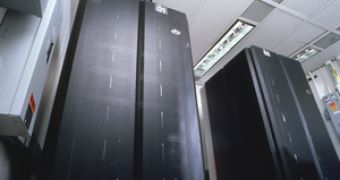
 14 DAY TRIAL //
14 DAY TRIAL // 













